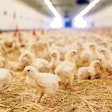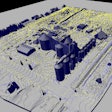Two friends share a beverage after a long day and during the discussion one of them asks, “I wonder if there’s a way to get more value out of my wheat midds?” On the surface, it seems like an innocent query to a common problem faced by wheat processors.
However, that simple question served as the genesis of an idea which has such far-reaching implications for processors, feed manufacturers, researchers, livestock operators, and even those involved in the economic development arena.
If you are a betting man, the odds that this comment would capture the attention of such a diverse group of stakeholders would be very slim. Slim that is, unless the person on the receiving end of the comment is Dr. Vern Anderson.
Dr. Anderson is an animal scientist with North Dakota State University, who’s headquartered out of NDSU’s Carrington Research Extension Center, Carrington, ND, and has been thinking about that question for some time now.
“The more I thought about the different possibilities for including midds in a ration, the more I started thinking about other co-products and the values they bring to a ration,” Anderson recalls. “The question in my mind then became, ‘What if instead of utilizing co-products as an additive component, they were combined to create a new class of feedstock?’ With a seemingly endless supply of co-products at our disposal, as a researcher, it seemed to me like a concept that warranted further development,” he adds.
A nutrient stew
If you think the search for nutrient-rich co-products and components ends with wheat midds, you would be wrong. Actually, Dr. Anderson has been working with a wide array of products ranging from beet tailings to DDGS to malt barley sprouts, for years. Better yet, these and other ingredients are readily available as North Dakota is blessed with a very diverse crop base.
Dr. Anderson needed help in getting this project going, so logically, he turned to a familiar resource, the Northern Crops Institute (NCI).
“Because of our agricultural diversity, we [NCI] have worked with many co-products to assay their nutrient value and relative feed value,” says Kim Koch Ph.D., feed production center manager, Northern Crops Institute, Fargo, ND. “Along with primary crops such as corn, barley, field peas and wheat, these co-products offer a nearly unlimited number of combinations for creating a feedstock with exceptional nutrient value. The trick is putting it all together in a formulation that is efficient, cost-effective and delivers end-user value.”
In other words, the time had come to give this concept more structure, expertise and more importantly, financial support, from a wider stakeholder base.
From idea to initiative
Fortunately for Anderson and Koch, their search for support and structure kept them near Fargo and Carrington, with the addition of Steve Edwardson, the executive administrator of the North Dakota Barley Council, Fargo; and Donald Frye, economic development consultant for Ottertail Power Co., and the mayor of Carrington, to the team.
As the group prepared to move forward, the project was given a formal name as the Central Dakota Feeds Initiative (CDFI). As Edwardson recalls, the next task was to create and memorialize objectives and a working plan to move the project ahead.
“Our mission statement says the CDFI exists essentially to develop value-added feed products that are regionally manufactured utilizing co-products with local, regional, national and international market potential,” says Edwardson. “The Initiative’s goal is to determine the potential for expanding utilization and acceptance of these unique feed products.
“If successful, the Initiative stands to bring a great benefit to North Dakota grain producers and processors and bolster the local economies where these people live and work,” Edwardson notes.
That economic development opportunity should not be overlooked, and it is a vital spoke in the hub of the Initiative. Many communities throughout farm country are struggling in tough economic times to maintain their identity and economic promise; however, people like Don Frye liken the Initiative’s potential impact for rural North Dakota to what the silicon chip has done for the Bay Area in California.
“The state is blessed with first and foremost, a diverse and vital agricultural base which allows us to create new feed products more easily than anywhere else in the country,” says Frye. “Cities like Carrington are ideally located along major highway and rail transportation routes, so getting products to the processing centers and out to the world is relatively easy, and from an economic standpoint, we enjoy some of the lowest utility rates in the country.
“Combine these production advantages with incentives and marketing efforts of the State Department of Agriculture, and you can make a very compelling case for succeeding in cities like Carrington, Devils Lake and elsewhere in the state,” Frye notes.
With the promise of opportunity comes the promise of jobs — jobs for those who construct and remodel mills and processing facilities; jobs for those who operate these facilities and employment opportunities in the production agriculture sector as well.
In fact, the economic development opportunity is so important to this effort, the Initiative’s formal administrative body is comprised of a joint effort between the Carrington Job Development Authority and Forward Devils Lake.
This co-mingled effort between economic development and research is one of the facets of the CDFI which make it so interesting. Efforts to raise the seed money to initiate product research and to develop a business modeling tool have borne fruit in the form of financial support from state and federal agricultural and economic development sources, commodity groups, private industry, foundations and private utility providers.
With a price tag of nearly $500,000 to move the CDFI forward, the monies are for three key research and development tasks: nutritional and feasibility studies and a business modeling plan.
The nutritional study is about 50% complete, with its focus on the feed manufacturing and beef feeding pilot trials. Trials encompass creep feed, grower/finisher, cow and bull feeding studies in beef; calf, grower and lactation studies in dairy and nursery, grower/finisher and sow trials for swine.
Feasibility study work is underway and centers primarily on how best to source co-products and studying their costs, location and availability. Identifying transportation issues and defining potential target markets both domestic and abroad round out the study.
“The feasibility study is especially important as it will provide the data necessary to help decide which feed products and in what form, will be introduced to the marketplace,” says Anderson. “Combined with the feeding trials, these are the two linchpins of the Initiative.”
Of most interest to the development community is the site and business plan development effort. Centrally locating future feed receiving and manufacturing facilities to accommodate the outbound flow of feed products, requires deep study of many factors.
“Site selection will most likely be determined by which areas in the state offer distinct advantages for being located near established, reliable supplies of co-products; and proximity to major transportation routes,” Edwardson surmises.
“A computer model is in development which would factor in all the fixed costs and potential market value capture of this entire process,” says Edwardson. “Once completed and tested, this model would provide an accurate financial and operational analysis of the purchasing, manufacturing and marketing potential for novel feed products in a given area. This tool provides processors with a chance to assess the market opportunity using real-world data for their region which, in turn, helps the operator make a better informed business decision relative to novel feed product production.”
Yes, but does it work?
When an idea is in the “idea phase,” everything is possible. This is the reason why researchers exist, to prove or disprove an idea.
Although Messrs. Anderson, Koch, Edwardson, Frye, et al firmly believed the concept of procuring the co-products necessary to manufacture a nutrient-dense, commercially viable feed product was possible, nothing is certain until the idea is tested at the ultimate proving ground . . . the feed bunk.
“Our beef trials have been very promising,” says Anderson. “When fed as a primary ration rather than a supplement, we are reporting performance equal to or better, compared to conventional rations. This is significant because in some cases we have reduced the amount of corn in the ration from a range of 60% to 0%, and lost no performance.
“In years when corn is in short supply or at high costs, to achieve that level of performance could offer feed manufacturers enormous flexibility in mixing without compromising nutrient value,” Anderson adds.
For Kim Koch, his work has revealed that while the end product can take several different forms, a pelleted end product holds clear advantages.
“Looking at co-products like malt barley sprouts and DDGs with peas creates a product that has flexibility to satisfy needs for ranchers looking for a range cake type pellet or a smaller 1/4- to 3/8-inch pelleted feed,” says Koch. “In my opinion, the key takeaway from research thus far is the importance to stay nimble and flexible when designing the feed. The success will be in meeting the end-user need with a product that performs to the end-user’s specifications both nutritionally and within their management system.”
For a dose of real world expertise, enter Dave Polries, president of Dakota Dry Bean, Grand Forks, ND.
“For me, I’m constantly looking three to five years out for ways to grow, modernize or otherwise improve my business,” Polries states. “Since I deal with many co-products, especially those derived from pea processing, what the group was proposing fit my business model very well.
“By creating a feedstock out of a variety of parts which may have little perceived value, feed makers can capture value and pass it on to their customers with a product whose sum is truly greater than its parts,” Polries points out.
For Polries’ part, he serves on the CDFI’s executive committee and is leading the effort to manufacture and commercialize the feed product. He echoes Koch’s sentiments about being flexible enough to meet customers’ needs, while delivering a top performing product.
“The potential really excites me or I wouldn’t have jumped onboard,” he says. “It could be a huge boon to those who have struggled to find a home for co-products and screenings, and other byproducts.
“In my eyes, the advantages of delivering a ration that’s premixed, pelleted easier to handle, has less waste and is easy to transport, would be desirable by anyone who raises livestock, whether they are located in the Northern Plains, out West or in the Pacific Rim,” Polries states.
Wait and see
While marketing and production of an end product is still far off in the horizon — expected launch date could arrive in the second half of 2010 — the CDFI remains an effort worth watching.
If anything, the CDFI has stamped a template on how to build a coalition of public, private and government stakeholders to rally around a central idea, without bogging down the process in political turf wars. If they can defy the odds and stay true to that model and bring a branded, novel-feed product to the marketplace, will others be far behind?
For researchers like Dr. Anderson, it could also represent a noticeable increase in invitations to noodle around an idea or two over a libation. Talk about value-added research!

















